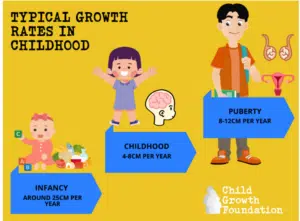20th September 2024
In support of Child Growth Awareness Week, 2024, this iHV Voices blog has been written by Lisa Hill, Paediatric Endocrine Nurse Specialist, Child Growth Foundation & Sally Majid, Growth Nurse Specialist, Child Growth Foundation, on this important topic for all health visiting practitioners.
The Child Growth Foundation (CGF) is a UK charity that supports families with concerns about their child’s growth, as-well as those under investigation or with a diagnosed growth condition. They support several rare overgrowth and undergrowth conditions.
When should we be concerned about a child’s growth?
Growth in childhood can be key in establishing any issues with a child’s general health and well-being. Chronic illnesses, psychosocial deprivation and genetics will all have an influence – identifying whether it’s a cause for further investigation or simply a normal variant is where the puzzle begins.
Due to the health visitor’s unique role in reaching and supporting all families with children under 5 years old, they are ideally placed to help identify concerns with child growth and ensure that all babies and children get the right support and early intervention to improve their outcomes. When visiting families and assessing babies and children, it is useful to think about the stages of growth to start putting the puzzle pieces together. Up until around the age of 2-3 years, nutrition is the main influencer on growth – having discussions around feeding/eating patterns, what their diet is and how they tolerate their food will help to identify any potential issues.
From the age of around 3 years until puberty, nutrition remains an important factor, but a child’s growth will be more heavily influenced by thyroid and growth hormones. This is also the point at which families may notice their child’s growth is different to that of their peers as they start to attend early years’ settings. They may raise their concerns about their child’s growth with you.
When discussing concerns with families about their baby or child’s growth, or when you recognise a growth concern as part of your assessment, there are many resources you can access to help inform you as to when further assessment and/or investigations are necessary.
During infancy, the most used resources are the ‘National Institute for Health and Care Excellence (NICE)’s Faltering growth: recognition and management of faltering growth in children’ guidelines and Royal College of Paediatrics and Child Health (RCPCH) recommendations.
After 3 years of age, when more consideration to family size is given, there are lesser-known recommendations that are important to be aware of and consider in your assessments. The CGF are fortunate to work with several medical advisors, who are experts in the field of recognising and treating growth conditions.
A recent article aimed at GPs, written by two of our charity’s Medical Advisors and others in the field, highlights four scenarios when a child presenting with short stature should have further investigations or assessments:
- A child presenting with symptoms of a chronic illness
- A child presenting with a height less than the 2nd centile
- A child with a height more than 3 centile spaces below that expected for their parents’ heights
- A child with growth failure (poor growth rate/height velocity), that is, a drop in height of more than 1 centile on the growth chart.
Additionally, the British Society for Paediatric Endocrinology and Diabetes (BSPED) Growth Disorders Special Interest Group recommend that practitioners use their helpful algorithm to determine the most appropriate referral for short stature – you can access the algorithm here.
These BSPED clinical standards highlight the importance of monitoring a child’s height to detect and ensure the timely referral of growth conditions. Despite child growth monitoring forming part of the Healthy Child Programme Schedule of Interventions, families contacting the CGF report that there is wide variation in the practice of child growth measurement (length/height) across health visiting teams in the UK. This can depend on individual health visiting teams due to variations in service specifications, their confidence and the availability of suitable equipment. As highlighted in these recommendations, considering a child’s growth against their genetic potential is important, monitoring height and obtaining a child’s mid-parental height (MPH) is an essential element of a thorough assessment.
The CGF has produced this short video explaining how to calculate a child’s MPH: Mid-parental height. If a child’s measurements are within 2 centiles either side of their mid-parental height, they are within the expected range for their family stature. Those measuring outside of those parameters require additional health assessments and review of their growth rate, which may lead to further investigations.
It’s important to be aware that babies born small for gestational age (SGA) need additional scrutiny of their growth. Most babies born small for gestational age have catch up growth. However, 10% of those children do not. Under these circumstances treatment is available and can be very effective.
Faltering growth can be a sign of many different health problems. It is rare that the cause of poor growth is an endocrine condition, but it sometimes can be the earliest or only sign. Poverty can also be a key driver. Recent research has shown that in England the most deprived areas have twice the prevalence of short stature compared with the least deprived. Inequities in accessing treatment is also a cause for concern that needs addressing – girls and ethnic minority groups with short stature are less likely to be referred, assessed, and treated. Delayed diagnosis of treatable conditions, presenting with early faltering height growth is common. These delays limit treatment options and lead to poorer clinical outcomes.
Alongside supporting families, the CGF’s nurse led Support Line is also available to all healthcare professionals with a concern or question about childhood growth and/or a growth condition.
A key activity of the Child Growth Foundation is to raise awareness and understanding of growth concerns and conditions, to support families in the child growth community, to improve detection, and support the earlier diagnosis of undergrowth and overgrowth conditions.
To help raise awareness, we have launched our new awareness campaign, made possible thanks to funding from Sandoz, and a range of other support from a number of organisations.
Our much-needed campaign aims to reach those who are concerned about their child’s growth to encourage them to leave no shadow of doubt, trust their instincts and get in touch with the Child Growth Foundation. As part of the campaign we have a new dedicated page of our website:
We’re here to help, and to make a difference wherever growth is a concern.
Links/references:
- Assessment of childhood short stature: a GP guide, Helen L Storr, Joseph Freer, Jenny Child and Justin H Davies, British Journal of General Practice 2023; 73 (729): 184-186. DOI: https://doi.org/10.3399/bjgp23X732525
- Overview | Faltering growth: recognition and management of faltering growth in children | Guidance | NICE
- Growth charts (rcpch.ac.uk)
- Inequalities in the assessment of childhood short stature, Justin H Davies, Jenny Child, Joseph Freer and Helen L Storr, British Journal of General Practice 2023; 73 (729): 150-151. DOI: https://doi.org/10.3399/bjgp23X732309





